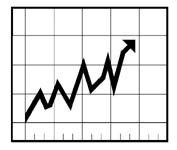Things are moving up
语 /漢語语 /漢語语 /漢語语 /漢語语 /漢語语 /漢語语 /漢語
Chinese or the Sinitic language(s) (汉语/漢語, Pinyin: Hànyǔ; 华语/華語, Huáyǔ; or 中文, Zhōngwén) can be considered a language or language family. Originally the indigenous languages spoken by the Han Chinese in China, it forms one of the two branches of Sino-Tibetan family of languages[3]. About one-fifth of the world’s population, or over 1 billion people, speak some form of Chinese as their native language. The identification of the varieties of Chinese as "languages" or "dialects" is controversial [4]. As a language family Chinese has an estimated nearly 1.2 billion speakers; Mandarin Chinese alone has around 850 million native speakers, outnumbering any other language in the world.
Spoken Chinese is distinguished by its high level of internal diversity, though all spoken varieties of Chinese are tonal and analytic. There are between six and twelve main regional groups of Chinese (depending on classification scheme), of which the most populous (by far) is Mandarin (c. 850 million), followed by Wu (c. 90 million), Min (c. 70 million) and Cantonese (c. 70 million). Most of these groups are mutually unintelligible, though some, like Xiang and the Southwest Mandarin dialects, may share common terms and some degree of intelligibility. Chinese is classified as a macrolanguage with 13 sub-languages in ISO 639-3, though the identification of the varieties of Chinese as multiple "languages" or as "dialects" of a single language is a contentious issue.
The standardized form of spoken Chinese is Standard Mandarin (Putonghua/Guoyu), based on the Beijing dialect. Standard Mandarin is the official language of the People's Republic of China, the Republic of China in Taiwan, as well as one of four official languages of Singapore. Chinese—de facto, Standard Mandarin—is one of the six official languages of the United Nations. Of the other varieties, Standard Cantonese is common and influential in Cantonese-speaking overseas communities, and remains one of the official languages of Hong Kong (together with English) and of Macau (together with Portuguese). Min Nan, part of the Min language group, is widely spoken in southern Fujian, in Taiwan (where it is known as Taiwanese or Hoklo) and in Southeast Asia (where it dominates in Singapore and Malaysia and is known as Hokkien).
Contents[hide] |
[edit] Spoken Chinese
The map below depicts the linguistic subdivisions ("languages" or "dialect groups") within China itself. The traditionally-recognized seven main groups, in order of population size are:
- Mandarin 北方話/北方话/ or 官話/官话, (c. 850 million),
- Wu 吳/吴 , which includes Shanghainese, (c. 90 million),
- Cantonese (Yue) 粵/粤, (c. 80 million),
- Min 閩/闽, which includes Taiwanese, (c. 50 million),
- Xiang 湘, (c. 35 million),
- Hakka 客家 or 客, (c. 35 million),
- Gan 贛/赣, (c. 20 million)
Chinese linguists have recently distinguished 3 more groups from the traditional seven:
There are also many smaller groups that are not yet classified, such as: Danzhou dialect, spoken in Danzhou, on Hainan Island; Xianghua (乡话), not to be confused with Xiang (湘), spoken in western Hunan; and Shaozhou Tuhua, spoken in northern Guangdong. The Dungan language, spoken in Central Asia, is very closely related to Mandarin. However, it is not generally considered "Chinese" since it is written in Cyrillic and spoken by Dungan people outside China who are not considered ethnic Chinese. See List of Chinese dialects for a comprehensive listing of individual dialects within these large, broad groupings.

In general, the above language-dialect groups do not have sharp boundaries, though Mandarin is the pre-dominant Sinitic language in the North and the Southwest, and the rest are mostly spoken in Central or Southeastern China. Frequently, as in the case of the Guangdong province, native speakers of major variants overlapped. As with many areas that were linguistically diverse for a long time, it is not always clear how the speeches of various parts of China should be classified. The Ethnologue lists a total of 14, but the number varies between seven and seventeen depending on the classification scheme followed. For instance, the Min variety is often divided into Northern Min (Minbei, Fuchow) and Southern Min (Minnan, Amoy-Swatow); linguists have not determined whether their mutual intelligibility is large enough to sort them as separate languages.
In general, mountainous South China displays more linguistic diversity than the flat North China. In parts of South China, a major city's dialect may only be marginally intelligible to close neighbours. For instance, Wuzhou is about 120 miles upstream from Guangzhou, but its dialect is more like Standard Cantonese spoken in Guangzhou, than is that of Taishan, 60 miles southwest of Guangzhou and separated by several rivers from it (Ramsey, 1987).
[edit] Standard Mandarin and diglossia
Putonghua / Guoyu, often called "Mandarin", is the official standard language used by the People's Republic of China, the Republic of China (on Taiwan), and Singapore (where it is called "Huayu"). It is based on the Beijing dialect, which is the dialect of Mandarin as spoken in Beijing. The governments intend for speakers of all Chinese speech varieties to use it as a common language of communication. Therefore it is used in government agencies, in the media, and as a language of instruction in schools.
In both China and Taiwan, diglossia has been a common feature: it is common for a Chinese to be able to speak two or even three varieties of the Sinitic languages (or “dialects”) together with Standard Mandarin. For example, in addition to putonghua, a resident of Shanghai might speak Shanghainese and, if they did not grow up there, his or her local dialect as well. A native of Guangzhou may speak Standard Cantonese and putonghua, a resident of Taiwan will probably speak both Taiwanese and putonghua/guoyu. A person living in Taiwan may commonly mix pronunciations, phrases, and words from Standard Mandarin and Taiwanese, and this mixture is considered socially appropriate under many circumstances. In Hong Kong, standard Mandarin is beginning to take its place beside English and Standard Cantonese, the official languages.
http://www.web-widgets.net/webapps/cid/517/705/employment/jobs.html


